
The genus Deilephila is part of the family Sphingidae, the hawk-moths or sphinxes. The genus was erected by Jakob Heinrich Laspeyres in 1809. It consists of a small number of Palearctic species most of which have common names involving the phrase "elephant hawk moth". They include the elephant hawk moth, Deilephila elpenor; the small elephant hawk moth and the Chitral elephant hawk moth. The oleander hawk moth is sometimes classified in this genus as D. nerii, but sometimes treated in genus Daphnis.
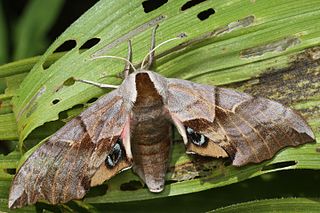
Smerinthus saliceti, the Salicet sphinx, is a moth of the family Sphingidae. The species was first described by Jean Baptiste Boisduval in 1875.
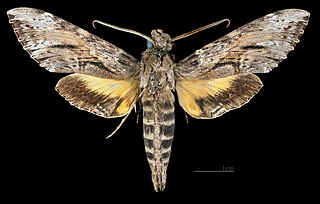
Isognathus rimosa, the rimosus sphinx, is a moth of the family Sphingidae. The species was first described by Augustus Radcliffe Grote in 1865.

Pachysphinx occidentalis, the big poplar sphinx, is a moth of the family Sphingidae. The species was first described by Henry Edwards in 1875. It lives throughout Canada and the United States. The habitat consists of riparian areas and suburbs.

Proserpinus clarkiae, or Clark's sphinx, is a moth of the family Sphingidae. The species was first described by Jean Baptiste Boisduval in 1852. It is known from British Columbia and Washington south through California to Baja California, east to Idaho, Wyoming and Utah. The habitat consists of oak woodland and pine-oak woodland in foothills.

Theretra silhetensis, the brown-banded hunter hawkmoth, is a moth of the family Sphingidae described by Francis Walker in 1856. It lives in Indo-Australia, India, Sri Lanka, Papua New Guinea, East Australia, Solomon Islands, Fiji Islands, Vanuatu Islands.

Proserpinus lucidus, the Pacific green sphinx or bear sphinx, is a moth of the family Sphingidae first described by Jean Baptiste Boisduval in 1852.

The willowherb hawkmoth is a moth in the family Sphingidae. The species was first described by Peter Simon Pallas in 1772.

Proserpinus is a genus of moths in the family Sphingidae, the sphinx moths or hawk moths. Species of the genus are native to North America with the exception of P. proserpinus, which has a much larger range extending from Asia to Africa. The genus was erected by Jacob Hübner in 1819.
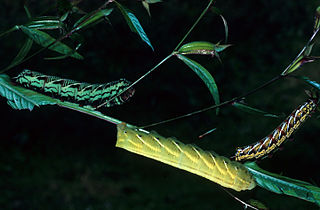
Proserpinus juanita, the Juanita sphinx, is a moth of the family Sphingidae first described by Herman Strecker in 1877. It is found from the US states of Montana and North Dakota, south to Arizona, and east to Missouri and Texas.

Hippotion boerhaviae, the pale striated hawkmoth, is a moth of the family Sphingidae.

Hippotion velox, the dark striated hawkmoth, is a species of sphingid moth or the family Sphingidae. The species was described by Johan Christian Fabricius in 1793.

Macroglossum glaucoptera, the dark hummingbird hawkmoth, is a moth of the family Sphingidae. It was described by Arthur Gardiner Butler in 1875. It is known from Sri Lanka, Thailand, southern China, Vietnam, Malaysia (Peninsular), Indonesia and the Philippines (Mindanao). Single specimen recorded from Papua New Guinea.

Adhemarius palmeri is a moth of the family Sphingidae first described by Jean Baptiste Boisduval in 1875.

Hyles livornicoides, the Australian striped hawk moth, is a moth of the family Sphingidae first described by Lucas in 1892. The larvae are known by the common name Yeperenye caterpillar, in the Arrernte language the caterpillars are referred to as Ayepe-arenye.

Proserpinus flavofasciata, the yellow-banded day sphinx, is a species of hawk moth which occurs at the edges of, and in clearings in, boreal and mountain forests across Canada, as far south as Maine and Massachusetts in the east and as far north as Alaska in the west. It is much more common in the west of its range.
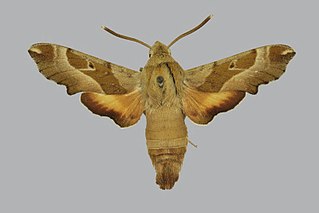
Proserpinus gaurae, the proud sphinx moth, is a moth of the family Sphingidae. The species was first described by James Edward Smith in 1797. It is found from Texas and Louisiana east to northern Florida, north to Alabama, Missouri, northern Georgia and South Carolina. It may range as far south as northern Mexico.

Proserpinus vega, the vega sphinx moth, is a moth of the family Sphingidae. The species was first described by Harrison Gray Dyar Jr. in 1903. It is found from southern Arizona, New Mexico and Texas south into Mexico.

Adhemarius daphne is a species of moth in the family Sphingidae. It was described by Jean Baptiste Boisduval in 1875, and it is known from Brazil, Bolivia, Argentina and Paraguay, as well as Cuba and Costa Rica.
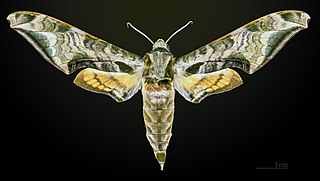
Protambulyx astygonus is a species of moth of the family Sphingidae first described by Jean Baptiste Boisduval in 1875. It is known from Bolivia, Paraguay and Brazil.




















